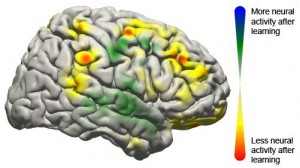 “UW CSE’s Raj Rao and UW collaborators Jeff Ojemann, a professor of neurological surgery, and Jeremiah Wander, a doctoral student in bioengineering, published their results online June 10 in the Proceedings of the National Academy of Sciences.
“UW CSE’s Raj Rao and UW collaborators Jeff Ojemann, a professor of neurological surgery, and Jeremiah Wander, a doctoral student in bioengineering, published their results online June 10 in the Proceedings of the National Academy of Sciences.
“In this study, seven people with severe epilepsy were hospitalized for a monitoring procedure that tries to identify where in the brain seizures originate. Physicians cut through the scalp, drilled into the skull and placed a thin sheet of electrodes directly on top of the brain. While they were watching for seizure signals, the researchers also conducted this study.
“The patients were asked to move a mouse cursor on a computer screen by using only their thoughts to control the cursor’s movement. Electrodes on their brains picked up the signals directing the cursor to move, sending them to an amplifier and then a laptop to be analyzed. Within 40 milliseconds, the computer calculated the intentions transmitted through the signal and updated the movement of the cursor on the screen.
“Researchers found that when patients started the task, a lot of brain activity was centered in the prefrontal cortex, an area associated with learning a new skill. But after often as little as 10 minutes, frontal brain activity lessened, and the brain signals transitioned to patterns similar to those seen during more automatic actions.
“‘Now we have a brain marker that shows a patient has actually learned a task,’ Ojemann said. ‘Once the signal has turned off, you can assume the person has learned it.'”
Anyone who would like to have his or her skull drilled for science is invited to contact Rao via email.
Read more here.

